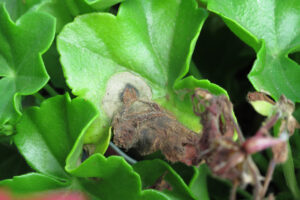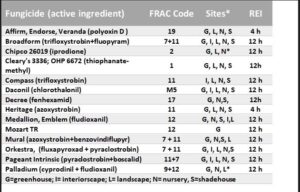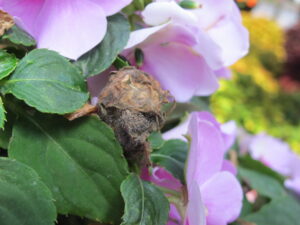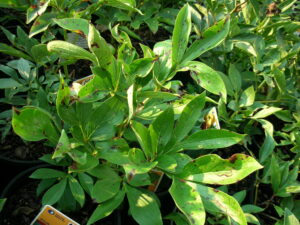Botrytis blight (also called grey mold) is caused by fungi in the genus Botrytis. The best known of these fungi, Botrytis cinerea, can infect many different hosts, including soft fruit, vegetables, annuals, perennials, shrubs and young tree seedlings (Fig. 1). Other common species of Botrytis are more host specific, including Botrytis elliptica (infecting only lilies and gladiolas), Botrytis paeoniae (infecting only peony) (Fig. 2), and Botrytis tulipae (infecting tulips).
- Figure 1. Impatiens, geranium, and begonia are all highly susceptible to botrytis. Photo by Janna Beckerman.
- Figure 2. Botrytis paeoniae, a common pathogen of peonies. Photo by Janna Beckerman.

Figure 3. Botrytis cinerea that infected fallen flower, spreading to leaves and sporulating. Photo by Janna Beckerman.
Botrytis blight often begins as a leaf or flower spot that continues to grow, expanding into a shoot blight or even crown rot. Signs of Botrytis infection include fuzzy grey mold on buds and flowers that can continue to spread to leaves and shoots (Fig. 3). This fuzzy growth consists of hyphae, fungal threads Botrytis uses to feed off the plant. At the same time, the fungus is producing hundreds of thousands of spores from a single lesion. Spores are spread by wind and rain to nearby plants to repeat the process. Leaf wetness is necessary for spores to germinate and infect. When weather conditions change (hot, dry summers or snowy winters) the fungus produces sclerotia, a fungus ball of hyphae that allow it to survive changing environmental conditions. In the spring, the cycle begins when sclerotia germinate, producing hyphae that can directly infect crowns or produce more spores to spread and infect flowers and foliage. In production, we often see outbreaks in the spring corresponding to overcast, cool weather and high humidity in greenhouses, shadehouses and nurseries.
Cultural management of botrytis blight include reducing leaf wetness by adequately spacing plants and avoiding overhead irrigation; removal of decaying or damaged flowers and leaves and disposing of spent plant material at the end of the growing season. Not surprisingly, some plants have been identified as being less susceptible to botrytis blight. In general, single flowered peonies (like Krinkled Red and Krinkled White) are more resistant to Botrytis than ‘bomb’ type of flowers. Keep in mind that disease-resistant doesn’t mean immune, and that infection can still occur under persistently cool, wet conditions, particularly if plants receive excess nitrogen fertilizer or get damaged by heavy rain, hail, or pests (animal, insect and human!). For a comprehensive list of resistant annuals and perennials see Disease Resistant Annuals and Perennials in the Landscape.
Trying to control botrytis blight on susceptible plants in the landscape is a challenge and will require repeated application of fungicides every 7-14 days. Sprays should focus before bloom, to aid in the protection of blooms, in the case of cut-flower peony.

All fungicides perform best when applied before symptoms appear (e.g., as flower buds develop or to protect new growth), and their use needs to be continued when conditions are favorable for disease.

